The American Society of Home Inspectors (ASHI) says 60% of American homes have got wet basements and shockingly 38% of them potentially have basement mold. With this, the market size of sump pumps reached double digits in 2018 with an upward trend in the coming years.
It means people are buying these pumps and continue to have them. Such a promising market understandably pushes the brands for bringing ‘MORE’ at ‘LESS’, which is why combo pumps are getting hugely popular.
Tons of products with variable performance and quality are in order and waiting to be picked by homeowners. To make your purchase a pleasant experience, we’ve reviewed several models and finally given the nod to the Wayne WSS30VN as the best combination sump pump in the market.
Another worthy mention is the Wayne Gurdian Sump Pump which is a bit costly but provides premium features and quality.
However, we understand you may want to explore more. So, you’ll need to learn if a combo is the right thing to consider in the first place. We’ll also explain what matters when you choose. Finally, we’ll let you know about our top pick plus a few more.
So, without further ado, let’s get started!
Why Should You Get a Combo and Not a Primary or Backup Alone?
Having one pump in place may be enough for many, but not for those whose basement is excessively or unusually damper than others’. Imagine a situation when downpours are rather frequent than occasional, and so is a power outage. You surely need a backup (battery backup system to be specific).
Buying one may seem okay but only moneywise. However, getting a combo (all in one) is always a wiser decision since the cost isn’t very high. Now that you know why a combination is the better choice, you’ll want to find the right one.
How Do You Choose the Best Combination Sump Pump?
Certain steps are involved. First, choose the type of the pump. Focus on the size of your household needs. Figure out the required motor power simultaneously. Then, choose the float switch type. Finally, think about other factors like materials, smart features, etc. If you don’t go through these steps, your money can go to waste for sure.
You might be thinking we’ve forgotten about the budget. Not essentially! Keep this particular thought in your head all along the way you find the right combination sump pump. We’ll discuss each factor one by one. Let’s begin with the type.
Sump Pump Types
Four types are common. Instead of giving you so many details on each type, we’ll point out their advantages and limitations.
| Types | Benefits | Downsides |
| Submersible |
|
|
| Pedestal |
|
|
| Water-Powered |
|
|
| Floor Sucker |
|
|
So, you see submersible pumps are able to give the most convenient experience, and we’ve chosen these products for review with this very fact in mind.
Pump Size (Capacity)
Typically, it’s during the wet seasons when a sump pump becomes very busy, which is why, you should calculate the capacity based on the needs on a rainy day.
If the downpour is moderate, a sump pit used in average US households receives 20 inches of water in a 1-minute window. It makes 20 gallons per minute, give or take. It should be around 1,200 gallons per hour (GPH).
Add a safety factor to this calculation so that the sump pump size is good enough on most occasions. For this purpose, multiple the GPH by 1.5. You’ll get 1,800 GPH, and that’s the ideal size.
However, you may look for higher capacities, say 2,000 GPH. That’s completely your decision. Most of the combos we’ve included in this article come with a higher capacity.
Motor Power
Horse Power (HP) is the unit to consider in this case. It ranges from 1/3 HP to 3/4 HP with 1/2 HP being an ideal consideration for households located in areas with frequent downpours. Choose wisely because this specific number is closely associated with the price of a sump pump.
A 1/3 HP pump should serve most households while 3/4 HP ones are meant for those with larger bases and a lot of water in the basement to drain (around 2,500 GPH or more). Even, a 1/4 HP pump is good enough for some homes, but then again, it’s all about your preferences.
Float Switch
It’s basically a level sensor that alerts the pump as water levels rise in your sump pit. Depending on the way how it works, there’re four different types to choose from, each having its advantages and disadvantages.
| Type | Mechanism | Pros | Cons |
| Vertical | With the rising water level, it floats vertically and reaches a certain height. Then, it opens a circuit to allow the pump to start working. |
|
|
| Tethered | With a rise in the water levels, the float goes up and has the switch flipped by the tether. It turns the pump on. |
|
|
| Electrical | One or more floats travel inside a caged/protected enclave. There’s a sensor to locate the float and then turn the sump pump on or off as required. |
|
|
| Diaphragm | Rise in the water level causes the switch’s pressure to increase. As the increase is enough for the bladder to be compressed, the switch activates and turns a pump on. |
|
|
Cost and Replacement
Be prepared to spend a thousand bucks for the process because that’s the average cost. Most homeowners have to look at a number from $968 to $1,466.
The whole thing may seem costly, but the cost estimates given here include the price of the pump and installation charge, which is typically higher than the pump’s price. So, it’s no wonder to have a similar figure in mind during a replacement.
If you’re about to choose a submersible pump, make sure it’s placed below the ground level. Your basement reservoir is the typical location, and unlike pedestal pumps, submersibles require some digging and additional costs.
Housing Material
Some pumps use a thermoplastic housing while a few have stainless steel. Thermoplastic body having a waterproof epoxy coating is better than steel in many respects. Try to check if the housing is made with corrosion-resistant materials.
The internal components like rotor shafts and impellers are usually made of a variety of materials like aluminum, polyethylene, stainless steel, etc.
Maintenance and Replacement
You might want to consider this after the purchase. On the contrary, you’ll be better off knowing things before buying because then, the whole picture containing your overall experience and efforts in a few years after the purchase should be obvious, and you can decide with improved awareness. Let’s know about the average lifespan first and then the typical maintenance requirements.
The required considerations are clear to you, aren’t they? A close look at the following reviews would be the next BIG thing.
Best Combination Sump Pumps Reviews
We’ve created this list considering every important aspect of a combination sump pump so that households with any type of basement, amount of water to discharge, and budget may find a suitable match.
1. Wayne Upgraded Combination Back Up System
This combo consists of one 1/2 HP (100 Watt) primary and a 12V battery-powered secondary pump that runs on a 75 amp Wayne battery.
The all in one unit uses top suction intakes and requires a 16-inch basin to be installed in, and the setup doesn’t take hours (but only 15 minutes as advertised) or years of specialization. Larger sump basins can also be chosen.
The submersible type comes with an 8-foot power cord and weighs 46 lbs. Included with the package is a 1-1/2-inch NPT discharge that is easy to install and compliant with standard building codes.
Specifications
- Motor and Pump: Primary (1/2 HP / 100 Watts, 120V), Secondary (120V DC)
- Housing: Epoxy Coated Steel with Cast Iron Bottom
- Flow Rate (Standard): 64 GPM @ 10′ (Primary) and 25 GPM @ 10′ (Secondary)
- Dimensions (L x W x H) (Inches): 13.5 x 9 x 15.5
- Weight: 46 lbs.
- Manufacturer’s Warranty: 3 Years
Features
- Pump Mechanism: The pre-attached centrifugal impeller is designed for typical instances of water pressure and flooding.
- Performance: The primary pump funnels a maximum of 85 gallons per minute (GPM) at 0′ head with the secondary one flowing 48 GPM at 0′ head. A single charge should be good for discharging up to 10,000 gallons.
- Switch: The built-in mechanical float switch is tested up to 1 million cycles under variable settings.
- Material: The pump comes in a steel housing protected with epoxy coatings and a cast iron base. The Switch uses a thermoplastic flow diverter for its protection. The guide, lower, and upper guards of the float are made of stainless steel.
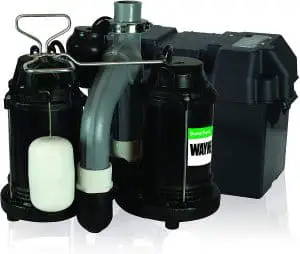
- Affordable and convenient (quiet operation) for common households
- Adequate force to handle common flooding occurrences
- Reliable float switch
- Good flow rate
- Easy setup (Mostly preassembled)
- Faulty battery indicators (false statuses reported by users)
>>>WAYNE WSS30VN Combination Sump Pump Review<<<
2. Basement Watchdog 1730 GPH Combination Primary and Back-Up Pump System
Its compact design makes it a good fit for small sump pits like the 12-inch ones. Its primary system works automatically when the power is available.
It looks like an upgrade from the above model, but not so much in real-life situations except for the smart features like remote notifications, alerts, wireless communication, etc. Alongside the float switches, a piggyback controller has been included. The installation process isn’t challenging at all.
Specifications
- Motor and Pump: Primary (1/2 HP, 115V, 60 Hz), Secondary (120V DC)
- Housing: Cast Aluminum / Iron
- Flow Rate (Standard): 3,450 GPH @ 10′ (Primary) and 1,850 GPH @ 10′ (Secondary)
- Dimensions (L x W x H) (Inches): 8.8 x 11 x 18
- Weight: 26 lbs.
- Warranty: 2 Years
Features
- Pump Mechanism: Including centrifugal impellers, the primary runs upon the availability of the AC power, and the battery backup system starts in the event of the primary being overwhelmed or power outage.
- Performance: A maximum of 4,400 GPH at 0′ head and 2,600 GPH at 0′ head can be expected.
- Switch: There’re float switches for both the primary and backup pumps which account for increased efficiency. The one for the main pump has a protective cage to help it stay clear of debris and hence the blockages.
- Material: Cast iron is the principal material with cast aluminum being used for some components. A plastic battery cap protects the battery fluid sensor.
- Wireless Connection: The built-in Wi-Fi module and CONNECT module make it easy for the owner to connect it via Remote Terminal or w/Data Port for alerts and remote notifications
- Alerts: Multiple alert systems are available for informing the owner of different statuses like AC power interruption, low battery and fluid, activation, and blown fuse.
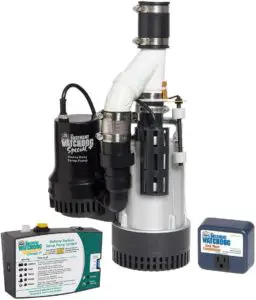
- An affordable combo with decent flow and discharge rates
- Dual float switch sets for better serviceability
- Wireless connection with multiple alert systems for great usability
- Easy installation (mostly pre-assembled)
- Extendable runtime with 2 similar batteries
- Not much of a reliable housing (high susceptibility to water damages in case of prolonged contact)
>>>Basement Watchdog Review<<<
3. Zoeller Aquanot ProPak53 Preassembled Sump Pump System
It’s another all in one unit with a special focus on the controller, warning systems, and indicators. All check valves, tee, and adapters come included with the package. You can expect from 5.5 to 7.5 hours of runtime on a single charge using the recommended system settings.
Using Vortex impellers, the automatic pump offers smart features that are typical of a modern combination sump pump. Its compact build fits in small pits and the pre-assembled state allows for an inexpensive drop-in installation. It uses a 1-1/2” NPT discharge having an inline check valve.
Specifications
- Motor and Pump: Primary (1/2 HP, 115V, 1-Phase, 1550 – 3450 RPM), Secondary (120V DC)
- Smart Controls and Highlights: Overcharge protection system, Battery burn-out indication, Wireless connection for alerts, and diagnostics
- Flow Rate (Standard): 2,040 GPH @ 10′
- Dimensions (L x W x H) (Inches): 8.50 x 8.50 x 10.50
- Weight: 17 lbs.
- Warranty: 3 Years (Limited)
Features
- Pump Mechanism: A non-clogging vortex impeller works efficiently to facilitate the flow and discharge of water accumulated in the basement.
- Performance: Maintaining the regular flow rate, the pump can make it up to 2,580 GPH at 5′ and even higher at 0′ lift.
- Switch: There’re two mechanically operated switches which aren’t dependent on each other for their functionality or efficiency.
- Material: The housing uses industry-standard materials whereas the impeller uses glass-filled thermoplastics for better movement and durability.
- Safety: An automatic safety system is in place to take care of the AC pump during a power outage. You’ll know if the battery burns out, any ‘overcharging’ incident happens, or if any maintenance is required. The alarm system is useful, and the battery box can be locked for added protection.
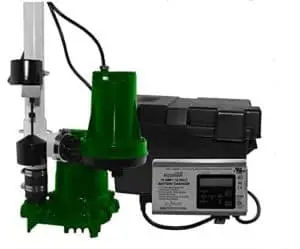
- Very compact and lightweight to fit in small pits
- High-performance impeller
- Z Control® for common and advanced system data and notifications
- Possible performance enhancement (recommendations provided)
- Fully functional alarm, indicators, and other safety components
- A little costlier than most other models
- Higher flow rate expected
4. Superior Pump Battery Back Up Submersible Sump Pump
It’s neither electrically powered nor a combo but a battery-operated simple pump that uses a 12V AGM Deep Cycle battery and handles up to 1/8-inch solids. The discharge size is 1.25 inches, and the power cord is 10-foot long.
The pump operates optimally within a liquid temperature range from 32° F to 120° F. its warning systems include the power activation alert, battery, power, and fuse status. After all, you shouldn’t just throw away your primary pump for this one.
Specifications
- Motor and Pump: 120V DC, 12 Amps, 1/3 HP
- Housing: Thermoplastic
- Flow Rate (Standard): 1080 GPH @ 10′
- Shut-off Head: 21′
- Charger: 2-Amp AC
- Dimensions (L x W x H) (Inches): 13 x 10 x 16.5
- Weight: 12.5 lbs.
- Warranty: 1 Year
Features
- Pump Mechanism: This submersible pump is loved by many for its simple mechanism and quiet operation (not essentially the quietest though).
- Performance: The flow rate may seem inadequate for areas which are prone to heavy flooding. It’s 1300 GPH at 0′ and slightly lower at 5′.
- Switch: The tethered switch simplifies the overall operation, but it’s the reason why you may need a wider basin for the installation of this pump.
- Material: Thermoplastic is at the core of the housing, base, battery box, and impeller. The fasteners use stainless steel and the motor shaft seal is made of carbon steel.
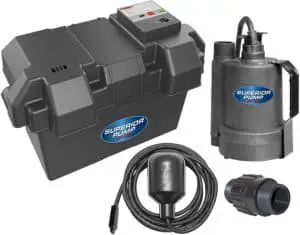
- A basic submersible pump for households with ‘light to moderate’ wet basement issues
- Affordable and compact
- Efficient discharge system
- Standard indicators and warning systems with an alarm and mute
- Very easy installation (no special tools required)
- Reported instances for relatively quicker battery discharge (after 70% consumption)
- Short Warranty Period
5. PumpSpy WiFi Battery Backup Sump Pump System with Internet Monitoring & Alerts
Few battery backup pumps are as good as the PS2000 when it comes to the compatibility of a secondary sump pump with the primary.
On the plus side, the idea of automation into a pump has been made to be real and practicable, thanks to the technological and mechanical excellence that PumpSpy has demonstrated.
Specifications
- Motor and Pump: 120V, 18 Amps, 0.33 HP DC (Brushless),
- Housing: Automotive Grade Materials with epoxy sealing
- Flow Rate (Standard): 2,400 GPH @ 10′
- Runtime: 5.5 Hours
- Maximum Flow: Up to 13,000 gallons on a single charge
- Dimensions (L x W x H) (Inches): 16 x 17 x 11
- Weight: 14.3 lbs.
- Warranty: 3 Years
Features
- Pump Mechanism: There isn’t much to say about the mechanism except the fact that it includes everything that a typical battery backup pump does.
- Performance: There you got a powerful companion as its flow rate is 2,990 at 5′ and even more at 0′. It runs about 166 hours with a 5-minute cycle and delivers up to 5.5 hours of constant service.
- Switch: The pump’s got dual float switches that are designed for separate functions.
- Material: It’s made of automotive grade material having water-resistant epoxy sealing to protect the components.
- Alerts, Indicators, and Stats: You’ll get alerts directly on your phone or check the status of virtually everything like main pump overuse and failure, power outage, overwhelming water level, blocked discharge line, discharging/dying battery, pump cycles, gallons per hour, etc.
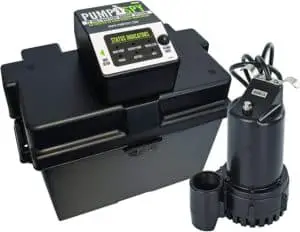
- Compliant with any standard main sump pump
- Automatic initialization and frequent system tests to ensure optimal performance
- Easy (foolproof) setup with color-coded connectors
- Nearly effortless maintenance (except for too old people)
- Lots of ways (smart features) to inform you how the pumps and the overall system is working
- A little bit overpriced
- Slow Wi-Fi connection
6. Liberty Pumps PC-Series Combination Sump Pump
We’ve got another compact combo that requires a sump basin which measures least 15 inches. The pre-assembled package doesn’t pose any critical challenge during installation. Each of the pumps includes an independent float switch.
Required discharge head can’t be any longer than 33 feet (primary) and 23 feet (secondary), and the size is 1.50 inches. Recommended batteries include Group 27 or 31 marine-grade deep cycle type which charges at five stages.
Specifications
- Motor and Pump: Primary (115V, 1/2-HP, 60Hz, 3450 RPM)
- Housing: Polypropylene with powder-coated aluminum
- Flow Rate (Standard): 2,640 @ 10′ (Primary) and 1,260 @ 10′ (Secondary)
- Dimensions (L x W x H) (Inches): 9.65 x 7 x 12.4
- Weight: 25 lbs.
- Warranty: 3 Years
Features
- Pump Mechanism: The oil-filled motor is hermetically sealed having thermal protection all around with the Vortex thermoplastic impeller for consistent performance.
- Performance: The combo can pump a maximum of 3,180 GHP (main) and 2,460 GPH (backup) at 0′ with the lowest being 1,980 GPH at 20′ (main) and 600 GPH at 15′ (backup).
- Switch: The vertical float switch (VMF) is a kind of specialty as it’s magnetically operated and uses vertical space instead of horizontal space to save you the hassles of worrying about unobstructed space.
- Material: The poly and aluminum casing containing stainless steel fasteners and rotor shaft makes for a durable housing.
- Alerts and Safety: Audible alarms and essential light indicators are available. Also, there’re required arrangements (protection) for overload, over-charging, and short circuits.
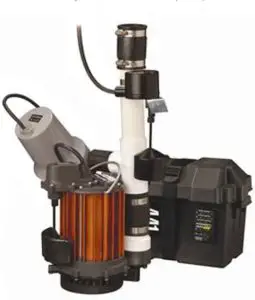
- Decent pumping capacity (flow rate)
- Enhanced cooling capacity, thanks to the aluminum housing
- Excellent solid handling up to 3/4 inch
- Reliable backup pump with an efficient charging system that gets tested continually
- Hassle-free installation with slip-on connectors
- Rotor shafts reported to corrode quickly
7. Glentronics Inc. 3000 GPH Pro Series Combination Sump Pump System
If you want a good all in one combination sump pump that fits in a small-size basin and makes good on pumping consistency, Glentronics has the answer, and it’s PS-C33.
With standard motors running on AC and DC power and essential components in place, this particular model exceeds average expectations. Thus, it’s no wonder it’s on our list.
Specifications
- Motor and Pump: Primary (1/3 HP-PSC, 120V AC), Secondary (12V DC, 9 Amps)
- Flow Rate (Standard): 3000 GPH @ 10′ (Primary) and 2400 GPH @ 10′ (Secondary)
- Battery Runtime (Fully Charged): 8 Hours Non-Stop, 24-36 Hours Non-Continuous
- Dimensions (L x W x H) (Inches): 11 x 10 x 23.7
- Weight: 45 lbs.
- Warranty: 3 Years
Features
- Design: There’re specifically designed output terminals to allow for a connection to your home’s auto-dialer or security system. The controller of the backup system has a fluid sensor integrated. Both pumps have raised (Sump Foot) platform.
- Performance: Not only does the automatic initialization of both pumps based on the availability of AC power help a lot in day-to-day operations, the combined pumping capacity is adequate for most homes.
- Switch: Four float switches are included (probably the highest number) including two for each of the pumps. Floats for the primary come caged for protection and are completely independent of those for the secondary.
- Ease of Use: You won’t be bothered about charging and battery maintenance. You can also silence the alarm in the face of a power outage.
- Alerts: You can benefit from the indicators and alarm in the event of irregularities, problems, etc.
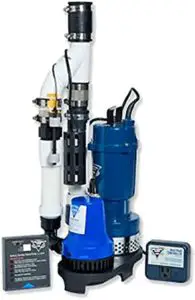
- Adequate flow rate for most households
- Smart monitoring device for ultimate convenience of users
- Safety features for peace of mind
- Multiple floats with automatic management requiring no manual intervention
- Very little maintenance required
- Considerably overpriced
- Not much quiet operation
8. StormPro 35ACi Deluxe Battery Backup Combination Sump Pump System
If you’ve believed so far that a combination sump pump doesn’t cost much, you’re probably going to have to ask why we’ve kept the 35ACi on this list. Well, the reason is its performance and overall lifespan.
Unlike an ordinary combo, this one includes as few moving parts as possible to keep the construction simple yet no less efficient. Moreover, its auxiliary pump isn’t a joke either, as with most budget combos.
Specifications
- Motor and Pump: Primary (1/3 HP PSC, 115V, 4.5 Amps), Secondary (12 VDC)
- Housing: Stainless Steel
- Flow Rate (Standard): 3,000 GPH @ 10′ lift
- Solid Handling: Up to 1/2 inch
- Dimensions (L x W x H) (Inches): 26 x 26 x 26
- Weight: 65 lbs.
- Warranty: 3 Years
Features
- Piggyback Alarm Sensors: Most switches fail to work properly due to a lot of moving parts which are absent in the couple of Digital Level/Alarm Sensors. These components also help figure out any potential malfunction.
- Performance: The main pump ensures a maximum of 4,080 GPH at 0′ lift. The flow rate can be up to 1,200 GPH at an increased lift (20′).
- Controller: This specific component adjusts the turn-on levels of the pump by up to 1/2″ increments. Besides cycling the two pumps, it minimizes the turn-on cycles alternating between the pumps.
- Power Inverter: The inverter functions as required to ensure the continuity of power supply and charging of the battery depending on the availability of the utility power.
- Digital Display: It gives you all the system data and notifications you need to make sure the pumps are running as they should.
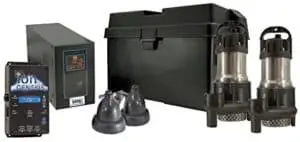
- Powerful combination sump pump with an excellent flow rate
- Perfect synergy between the components of both pumps
- Durable housing with high-quality components
- Efficient inverter system with smart digital readout
- Ion® Digital Sensors rated at (arguably) the highest cycles (2 million) for reliable performance
- Enclosure for the battery to protect it from corrosion
- Pretty expensive
- Poor solid-handling (not quite capable of the advertised number)
- Hefty build (not much of an issue though)
9. AiTurbo-ENi – Combination Sump Pump System
Like the StormPro 35ACi Deluxe, AiTurbo-ENi is far from being a budget-friendly sump pump combo. Unlike the 35ACi, it focuses on technological sophistication rather than just wireless connection or notification system.
While the manufacturer claims that it’s the only combination sump pump with artificial intelligence, you need to think what exactly it means and if you can really benefit from it and how.
Controlled by a microprocessor, this pump combo uses its own intelligence to make decisions regarding its day-to-day functions. Sounds interesting, right? Let’s get the details right off the bat.
Specifications
- Motor and Pump: 120 Volt AC / 12 Volt DC
- Housing: Thermoplastic
- Flow Rate (Standard): 5,580 GPH @ 10′
- Float On/Off: Adjustable
- Weight: 24 lbs.
- Warranty: 3 Years
Features
- AI and Smart Features: There’re alerts and notifications for virtually everything you can think of. Not kidding! You’ll be able to benefit from real-time monitoring, diagnostics, and alerts for sensor issues, plumbing defects (clogs and vapor locks), battery problems, etc. The AI Notification system and module let you stay informed of everything about the pump via wireless/wired connections even you’re on a vacation.
- Performance: Some homeowners want to pick up a big number on this. Well, how about 8,700 GPH at 0′ lift? For your information, it’s the combined flow rate.
- Switch: The dual switches ensure that you always have a float in action (one takes over upon another’s failure). The vertical design allows them to get assembled into tighter spaces. These switches float go up and get down on a vertical rod which is almost always fixed. So, they require less room to travel to the top.
- Material: The unit uses a thermoplastic housing which may not be as strong as stainless steel but surely durable if you’re concerned about this particular factor.
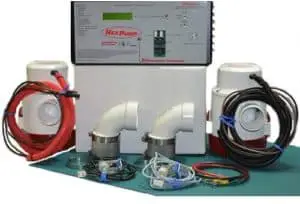
- More advanced and precisely built than 90% of the contemporary models
- A fully functional digital assistant at work for detecting and signaling associated plumbing issues
- Dual battery connections available for more extended runtime
- Separate sensors for alerting the owner of high water level and redundancy
- Diligent self-testing system with real-time tracking and diagnostics for consistent reliability
- A smart battery and charging management system
- Unable to handle solids
- Too expensive for average households
- Not very user-friendly for elderly folks
How Long Does a Pump Last?
Life expectancy isn’t the same for all pumps. An average of 10 years is typical. Still, the following factors help you determine how soon a replacement will be required.
- The schedule of the pump’s usage
- The length (distance) the pump carries the water for discharge
- The power source it uses
- AND it’s overall built quality and your maintenance routine
How Often Is It Good to Replace?
There’re no set rules for this. A good practice is to run a thorough inspection every couple of years since the date of your purchase until the end of its life expectancy. Some manufacturers provide insights into this. Follow if yours gives one.
8 Signs That Tell You Should Look for a Replacement
These signs are indicative of one potential situation that you want a new sump pump because the existing one is about to be out of order.
- Strange noises coming from the pump
- Excessive vibration as it starts running
- Too irregular uses
- Too prolonged operation (running about all the time)
- Frequent cycling on/off, especially during duty time
- Visible (heavy) rust
- Failing/Stuck motor (frequently or occasionally)
- 7+ years of regular usage since you purchased
Sump Pump Maintenance Checklist
These steps are almost compulsory if you want to have your sump pump in proper order. They also help you keep the pump up for actions to the fullest extent of its life expectancy.
- Check to see if the pump stays plugged in to a fully functional GFCI outlet. In case any of the GFCI breakers trips, reset it.
- Inspect the cord to ensure it’s in the right shape.
- Vibrations may cause the pump to tilt onto any side and jam its float arm to prevent the activation of the pump. So, keep the pump in an upright position.
- Check on the pump’s automatic initialization by pouring water into the sump pit. Service the pump if it fails to run automatically.
- The bottom of the sump pit needs to be free of stones or other solids. Remove the pump and clean it.
- Remove the screen of the pump and clean it. Some pumps use no screens but an inlet opening. Do the same.
- Check the positioning of the outlet pipes for proper joints and distance of discharge (20 feet far from the foundation)
- Clean the hole in the outlet pipe if it’s fully/partially blocked.
No weekly or monthly commitments are required. Just a quarterly or biannual maintenance job will be okay. Check our step by step guide to know the details about cleaning the sump pump.
That’s all we got! It’s time to sum up the whole thing. Don’t you think?
Our Final Verdict
We already pointed Wayne WSS30VN out as the best combination sump pump. The Glentronics PS-C33 comes next only because of its steep price.
What if you don’t essentially have to get a perfect combo? Well, the Superior Pump 92900 takes our spot for the best backup while the StormPro 35ACi is great too only if you’re comfortable with the price.
Finally, we can’t help giving the AiTurbo-ENi – Combination Sump Pump the credit for being a genuinely innovative package. The price could be a barrier, though.
What’s left of our discussion? Your ultimate choice, right? Happy buying!

